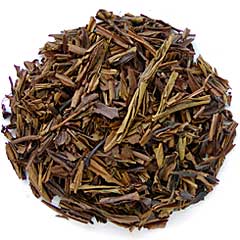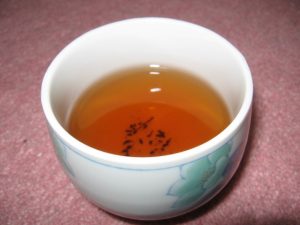Houjicha (ほうじ茶 or 焙じ茶, roasted tea) has a reddish brown color and a roasted fragrance.
has a reddish brown color and a roasted fragrance.
It is very popular in Kyoto, the place where the process to make houjicha was invented in the 1920s.
Judging by its color, it looks like the familiar black tea that you can order in any western restaurant.
However, houjicha is unoxidized (unlike black tea) and is made from other Japanese green teas, as we will see next.
How is houjicha made?
Houjicha is most commonly made with bancha, although it is also made with sencha and kukicha as well. The basic process consists of roasting the loose leaves at about 200 degrees celcius, followed by a quick cooling.
This process lowers the catechin and caffeine content of the leaves.
Why is this important? Because the catechin is the main source of astringency and caffeine an important source of bitterness in the tea.
Houjicha is a mild tea that is easy to drink and on top of that has very little caffeine. That’s why Japanese children and the elderly favor houjicha.
The video below shows the roasting of green tea leaves. Notice the color change when the roasted tea comes out.
Did you know that you can roast your own houjicha at home?
How to brew houjicha
Houjicha is brewed in the same way as bancha and genmaicha.
as bancha and genmaicha.
This method is the easiest because boiling water is added directly to the loose tea leaves and the brewing time is very short.
Measure 4 grams (1 teaspoon) per cup,and place it in the kyusu (Japanese tea pot: 急須). The following video shows a type of kyusu called dobin (土瓶).
Use 120ml (4 oz) of boiling water per cup, pour it in the dobin, close the lid and wait 30 seconds.
Now pour the houjicha into each cup. Don’t fill the first cup all at once, alternate from cup to cup as shown in the video. Pour until the last drop.




